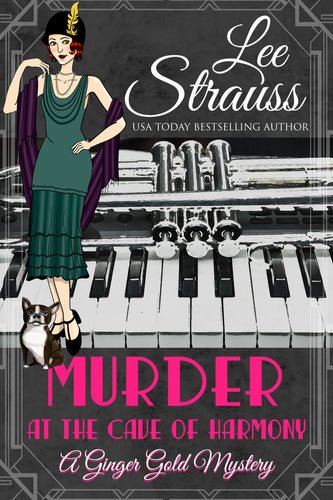Jazz Clubs in London in 1928: A Snapshot of Musical Vibrance and The Cave of Harmony
The year 1928 was a vibrant time for jazz in London (where Ginger Gold resides). The city, caught in the throes of the Jazz Age, pulsed with a new energy as venues sprang up to cater to the booming demand for this fresh, improvisational music. From smoky basements to grand dance halls, London’s jazz clubs provided an escape from the rigid social structures of the past and embraced a freer, more spirited approach to life. It was exciting for me to incorporate this atmosphere into my latest WIP, Murder at the Cave of Harmony.
The Jazz Age in London
Similar to the experience in the USA by Americans, London’s Jazz Age was fueled by the cultural shifts that followed the First World War. The somber mood of the previous decade gave way to a collective desire for celebration, fun, and innovation. Jazz, with its roots in African-American musical traditions and its emphasis on syncopation and improvisation, captured this spirit perfectly.
In London, jazz clubs became hubs of creativity and rebellion. These spaces were as diverse as their patrons, ranging from the opulent ballrooms of the Savoy Hotel to hidden gems tucked away in narrow streets. The music resonated with both the upper classes, eager for something new and exciting, and the working-class crowds, drawn by its infectious energy.

This could be a scene from my book!
A Cultural Melting Pot
Jazz clubs in 1920s London were cultural melting pots where people from all walks of life came together. This was a significant cultural shift, as the class system in London had been engrained for centuries. Young flappers with bobbed hair and daring hemlines danced alongside dapper gentlemen in tailored suits. Artists, intellectuals, and bohemians mingled freely with aristocrats and everyday Londoners. For many, these clubs were more than just places to hear music; they were sanctuaries of self-expression and modernity.
The Unique Allure of The Cave of Harmony
Among the many jazz clubs that dotted the city, The Cave of Harmony held a special place in the hearts of its patrons. Unlike the grandiose venues designed for large-scale dancing and entertainment, The Cave of Harmony offered an intimate and slightly eccentric experience. Nestled in an unassuming corner of London, its discreet entrance belied the vibrant world within.
A Distinct Atmosphere
Stepping into The Cave of Harmony was like entering another world. The club’s interior was a whimsical mix of styles: Art Deco influences mingled with touches of Bohemian flair. The dim lighting, punctuated by flickering candles and colorful lampshades, created an atmosphere of intrigue and warmth. Walls adorned with eclectic artwork and memorabilia hinted at the eclectic personalities who frequented the space.
The Cave’s intimate size meant that performances felt personal. Unlike the vast ballrooms where jazz could sometimes feel distant, here, the music enveloped you. Every note seemed to reverberate off the walls, drawing you into the performance.
A Haven for Creativity
The club’s founder, Elsa Lanchester, brought her unique vision to The Cave of Harmony. Known for her chestnut-colored curls and irrepressible energy, Elsa was a figure of fascination in London’s social circles. Her eclectic taste in music and art ensured that the club’s offerings were as varied as its patrons.

While jazz was at the heart of The Cave’s allure, it wasn’t the only attraction. Poetry readings, avant-garde performances, and comedic sketches were regular features. Elsa’s own performances, often tinged with wit and mischief, added a special charm to the proceedings.
Challenges and Triumphs
Operating a jazz club in 1920s London wasn’t without its challenges. The conservative elements of society viewed jazz with suspicion, associating it with moral decline and social upheaval. Venues like The Cave of Harmony occasionally faced scrutiny from authorities and the press. In fact, despite its reputation and long-lasting legacy, it only remained open for one year.
The Legacy of The Cave of Harmony
For modern historians and lovers of jazz, The Cave of Harmony remains a symbol of a time when music brought people together in unexpected ways. It stands as a reminder of the power of creativity to transcend social boundaries and ignite the human spirit.
I hope you enjoyed reading about the history of London jazz clubs, and the Club of Harmony in particular. Though Elsa Lancaster, a character in my book, is a real person, the murder that I show taking place at the Cave of Harmony is purely fiction.
Murder's off the scale!
Ginger Gold and her husband, Chief Inspector Basil Reed, enjoy a night out at the popular jazz club, the Cave of Harmony, run by the captivating Elsa Lancaster—a name well-known in London’s society pages in 1928. But after an evening of dancing and celebration, a band member plays a sour note and drops dead. What initially seems like a sudden, natural death soon turns sinister. A murderer is on the loose, and the Cave of Harmony is anything but harmonious.
With Ginger’s sister-in-law, Felicia, and her intrepid assistant, Magna Jones by her side, can they catch the killer before another musician hits a deadly note?
Murder at the Cave of Harmony is ready for PREORDER!


